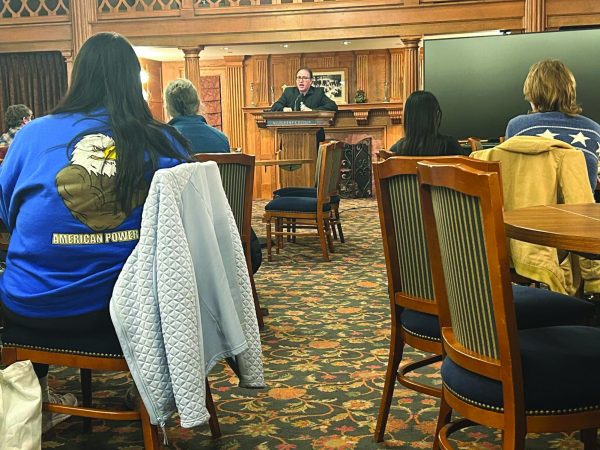Slayer’s scheme or guest’s graffiti?
April 14 marks 158 years since Abraham Lincoln was assassinated, but a Meadville hotel may have borne witness to Booth’s earlier plans
“Abe Lincoln departed this life August 13th, 1864 by the effects of poison” — or so a certain Meadville hotel guest may have hoped. The graffiti was found shortly after John Wilkes Booth stayed at the McHenry House in Meadville. They would not become infamous, however, until eight months later when Booth assassinated Lincoln at Ford’s Theater on Friday, April 14, 1865.
Before he became one of American history’s most notorious villains, Booth was called the most handsome actor in the country.
“Plays were a pretty popular form of entertainment,” said Ian Binnington, associate professor of history and dean for the student experience. “So, although it doesn’t seem very credible now to say that some of the superstars of the age are going to be people on Broadway, that would’ve been true. The Shakespearean actors were some of the biggest, kind of, what we could call celebrities of their day in the middle of the nineteenth century. He wasn’t the most famous Booth … but he was a pretty well-known figure.”
A Marylander by birth, Booth was decidedly not a Northerner, Binnington emphasized. Maryland, being a border state, did not secede from the Union. This does not mean that the state was wholeheartedly invested in the Union’s cause, however. After the Lincoln administration declared martial law, there was plenty of criticism of the Union in the state to go around. Binnington believes that Booth’s pro-slavery and anti-Lincoln views likely emerged from this attitude.
Booth had interests and pursuits beyond the theater, however. In January 1864, according to the American Oil & Gas Historical Society, Booth set out to expand his fortune in the fledgling oil industry in northwestern Pennsylvania, purchasing a lease near Franklin. Believing that he would earn more in the oil industry than the theater, Booth decided to leave the stage in May 1864 to focus solely on his Dramatic Oil Company, investing in other wells and traveling frequently to Pennsylvania.
Booth’s well near Franklin was initially prosperous, producing around 25 barrels of oil per day, but struggled under overhead costs. So, Booth decided to “shoot” the well, a process which, if successful, would greatly increase the well’s production. Unfortunately, after the well was “shot,” it ceased to yield oil altogether, leaving Booth and the Dramatic Oil Company in financial ruin by July 1864.
In the meantime, Booth had passed through Meadville several times, staying at the McHenry House near the railroad station. Accounts differ as to what, exactly, he was doing in town. Some sources, including an 1896 article from the Ann Arbor Register, claim that he was here for an acting gig — though, given his supposed retirement in May 1864, this seems unlikely — while others speculate that he was merely traveling and found Meadville to be a convenient and comfortable place to stay the night.
Regardless, at an indeterminate time in the summer of 1864, a chambermaid found the aforementioned inscription — “Abe Lincoln departed this life August 13th, 1864 by the effects of poison” — in room 22 of the McHenry House. R. M. U. Taylor, superintendent of the hotel, initially dismissed the engraving as nonsensical graffiti written by someone who disapproved of Lincoln. Once word spread that Booth had assassinated the president, however, Taylor began to connect the dots. He cut Booth’s signature out of the hotel register and framed it along with the pane of glass on a bed of black fabric, drawing national attention in the chaotic aftermath of the first presidential assassination in American history.
At first glance, this engraving may seem incongruous with Booth’s notorious assassination of Lincoln with his Deringer pistol. However, one of Booth’s accomplices in the assassination plot was David Herold, a clerk at Thompson’s Pharmacy in Washington, D.C., where Lincoln sometimes purchased medicine. It is speculated that there may have been an earlier plan involving Herold to poison Lincoln via his pharmaceuticals, which would have led Booth to write this inscription.
Booth’s successful assassination plan was not his first.
“There appears to have been a plan to ambush Lincoln on the way to the Soldiers’ Home, which is where Lincoln spent a fair amount of time,” Binnington said. “Booth also had a broader plan, and it wasn’t just Lincoln, he intended to assassinate three people. In one case, William Henry Seward, who was the Secretary of State, he was stabbed by the assailant but he lived. In the other case, which was the vice president Andrew Johnson, the guy bottled out — he got drunk and didn’t do it. So, what he (Booth) was hoping to do was kind of decapitate the Union government.”
Though Booth may have been plotting the assassination as early as 1864, historians and history buffs disagree on if the Booth engraving is genuine. Historian Neil Gale’s article “Early Portent of Lincoln’s Death,” which cites a February 1949 newspaper article from The Kansas City Star, claims that the engraving was found the morning after Booth checked out of the hotel on Aug. 13, 1864, aligning with Victor Louis Mason’s account of Booth’s visit in his book “Four Lincoln Conspiracies.” Roger Norton’s article disagrees, claiming that Booth’s only confirmed stays at the McHenry House were on June 10 and 29 of 1864 and that he never stayed in room 22, where the engraving was found. A further article published by the Crawford Messenger, a blog managed by the Crawford County Historical Society, falls in line with Norton, writing that Booth stayed on June 10 and 20. Meanwhile, a Crawford Democrat article from April 1865 claimed that Booth had stayed on June 4.
It is unclear which account is closest to the truth, but historical documents indicate which ones are doubtful. An employee at the McHenry House testified in a written statement to the Secretary of War that Booth had stayed on June 10 and 29 only and had never spent any time in room 22, according to the Crawford Messenger. Additionally, historical records show that Booth spent August 1864 between New York, Philadelphia and Baltimore, staying far away from northwestern Pennsylvania. However, the penmanship of the engraving has purportedly been linked to Booth’s own penmanship, indicating either a link, coincidence or a good forgery.
After assassinating Lincoln. Booth went on the run before eventually being cornered and killed twelve days later in Virginia. Herold, who escaped with him, was captured, tried and executed for participating in the conspiracy.
The McHenry House was partially destroyed following a kitchen fire in 1876. Though it reopened the following year, its return was brief — it was closed and demolished in December 1880.
The windowpane, meanwhile, was passed down from Taylor to a series of other owners until it eventually ended up in the possession of Ford’s Theatre in Washington, D.C., which now houses a museum dedicated to Lincoln.
In his diary, recovered from his body after his fatal shooting, Booth wrote: “Our Country owed all her troubles to [Lincoln], and God simply made me the instrument of his punishment.” Though Meadville plays but a small part in the sprawling plot to assassinate the sixteenth president and the exact provenance of the McHenry House etching may never be clear, Booth’s notorious legacy lives on.

Sydney Emerson is a member of the class of 2023. She is from Bradford, Pennsylvania and is an English major with a history minor.








Ron • Apr 29, 2023 at 7:48 am
Nice article. If you Google “The Magnificent McHenry House Part 2” (comments won’t all links) there’s some additional source material in that article which leans more towards the argument it was not Booth.